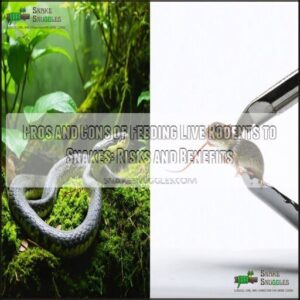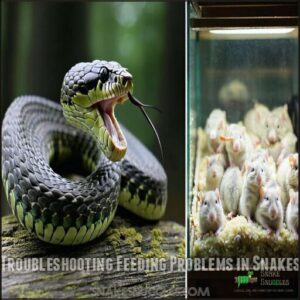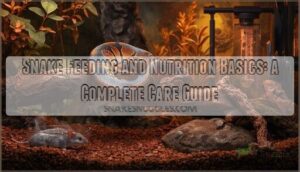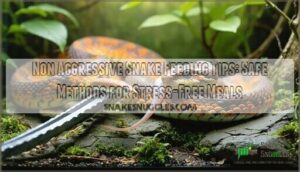This site is supported by our readers. We may earn a commission, at no cost to you, if you purchase through links.

On the upside, it’s natural—helping your snake awaken its hunting instincts. But live prey can fight back, injuring your snake with bites or scratches.
There’s also a risk of parasites or diseases hitching a ride on the rodents. While nutritious, live feeding is messy, stressful for both you and the snake, and may even be illegal in some places.
Frozen-thawed rodents are safer, just as nutritious, and way easier to store. Plus, no prey is panicking in the process. Finding the balance depends on your snake’s needs—and your comfort level.
Table Of Contents
- Key Takeaways
- Safety of Feeding Live Vs Frozen Rodents
- Nutritional Value of Live Vs Frozen Rodents
- Convenience and Practicality of Feeding
- Legal and Ethical Considerations
- Troubleshooting Feeding Problems in Snakes
- Making The Switch to Frozen-Thawed Rodents
- Frequently Asked Questions (FAQs)
- Is it bad to feed live mice to snakes?
- Are frozen or live mice better for snakes?
- Is it illegal to feed live mice to snakes in the US?
- Is it okay to leave a live rat in my snakes cage?
- What are the benefits of live feeding?
- Should I feed my ball python live or dead?
- Why is live feeding good?
- Are live feedings animal abuse?
- What if my snake only eats live prey?
- Can I feed frozen rodents to baby snakes?
- Conclusion
Key Takeaways
- Live feeding awakens your snake’s natural hunting instincts, but it risks injuries, stress, and exposure to parasites or diseases.
- Frozen-thawed rodents are just as nutritious as live prey, safer, and easier to store, making them a convenient choice.
- Feeding live prey can be messy, potentially illegal in some areas, and raises ethical concerns around prey suffering.
- Switching to frozen prey reduces health risks for your snake and cuts down on costs and hassle for you.
Safety of Feeding Live Vs Frozen Rodents
Feeding live rodents to snakes can pose significant safety risks, including injuries and disease transmission. Frozen-thawed rodents offer a safer alternative, minimizing harm to your snake while ensuring proper nutrition.
Risk of Injury to Snakes From Live Prey
Feeding live rodents to your snake might seem natural, but it comes with serious risks.
Feeding live rodents might mimic nature, but it exposes your snake to unnecessary injury, stress, and disease risks.
Rodent bites, scratches, and live prey aggression can cause scale damage, eye injuries, or even infections requiring costly veterinary care. In extreme cases, untreated wounds may lead to euthanasia.
| Risk | Live Prey | Frozen Prey |
|---|---|---|
| Rodent Bites | High | None |
| Scale Damage | Common | None |
| Eye Injuries | Possible | None |
| Infection Risk | Significant | Eliminated |
Frozen prey eliminates these snake feeding risks, ensuring safer, healthier meals.
Disease Transmission From Live Prey to Snakes
Live prey isn’t just risky for injuries—it’s a gateway for zoonotic diseases. Rodents can carry pathogens like Salmonella, parasites, and bacteria, posing serious snake health risks.
Freezing prey minimizes these dangers by killing harmful organisms.
| Disease | Transmission Routes | Prevention Methods |
|---|---|---|
| Salmonella | Feces | Freezing eliminates risk |
| Parasites | Skin contact | Pre-killed removes carriers |
| Hantavirus | Droppings, bites | Frozen prey stops spread |
| Bacterial infections | Bites, scratches | Freezing destroys bacteria |
| Mites | Fur, scales | Freezing eradicates pests |
Switching to frozen rodents reduces live feeding risks, protecting your snake from unnecessary disease transmission.
Live prey can also provide mental stimulation benefits, but the risks often outweigh this advantage.
Stress and Alarm in Snakes From Live Prey
Live feeding can trigger Predator-Prey Stress in captive snakes, especially those unaccustomed to hunting. The sudden movement of live prey often sparks a Fear Response, leading to snake stress and disrupted feeding behavior.
You might notice defensive coiling, food refusal, or erratic movements—clear Behavioral Indicators of discomfort.
Here’s a quick guide:
Behavior Impact What to Do
Avoiding live feeding reduces these risks, easing their physiological impact.
Benefits of Frozen-Thawed Rodents in Reducing Risk
Choosing frozen-thawed rodents over live prey isn’t just smart—it’s safer for your snake and you.
With frozen feeders, you’re eliminating bite risk, reducing parasite exposure, and ensuring safer handling. Plus, freezing kills pathogens, decreasing zoonosis threats that come with live rodent risks.
Here’s a quick breakdown:
| Risk Factor | Frozen-Thawed | Live Prey | Snake Health Impact |
|---|---|---|---|
| Physical Injuries | No injury risk | High injury potential | Injury prevention |
| Parasites | Minimal exposure | Significant parasite load | Reduced parasite exposure |
| Zoonotic Diseases | Pathogens killed | Disease transmission risk | Decreased zoonosis threat |
| Handling Safety | Predictable process | Unpredictable behavior | Safer handling |
Frozen-thawed vs live? It’s a clear win for ethical live feeding alternatives and your snake’s health.
Nutritional Value of Live Vs Frozen Rodents
In the context of nutrition, you might wonder if live rodents are better for your snake than frozen ones.
While freezing can cause slight nutrient loss, properly stored frozen prey still provides nearly all the essential proteins, fats, and minerals your snake needs, which includes the necessary components for a healthy diet with essential proteins.
Essential Nutrients Provided by Rodents to Snakes
Rodents are a powerhouse for snake nutrition, offering the perfect mix of protein, fats, vitamins, and minerals to support your snake’s health.
Their nutrient content mirrors what snakes consume in the wild, making them an ideal food source.
| Nutrient | Role in Snake Health |
|---|---|
| Protein | Builds muscle and tissue |
| Fats | Provides energy reserves |
| Vitamins (A, B, D) | Boosts immunity |
| Minerals (Calcium) | Strengthens bones |
This balanced rodent nutritional density guarantees your snake thrives, maintaining prime health and well-being.
Maintaining a proper diet also requires understanding snake vitamin D3 importance, which is crucial for overall snake health and well-being.
Impact of Freezing Process on Nutrient Retention
Freezing rodents is like hitting pause on their nutrient content, but how you freeze them makes all the difference.
Flash freezing keeps about 90-95% of the nutritional value intact, while slower methods can lead to greater nutrient degradation. Proteins and fats remain stable, but water-soluble vitamins, like vitamin C, take the hardest hit.
Here’s a quick breakdown:
| Freezing Method | Nutritional Retention | Vitamin Loss | Storage Duration |
|---|---|---|---|
| Flash Freezing | 90-95% | Minimal | 6-12 months |
| Quick Freezing | 85-90% | Low | 4-6 months |
| Slow Freezing | 70-80% | Moderate | 2-3 months |
| Refreezing | Below 70% | Significant | Not recommended |
To maximize snake nutrition, store frozen prey at consistent temperatures and avoid refreezing.
Proper thawing guarantees less impact on nutritional retention, keeping your snake’s diet on point without needing nutritional supplements.
Comparison of Nutrient Levels in Live and Frozen Rodents
Frozen-thawed vs live prey nutrition often sparks debate, but the differences in snake nutrition are minor.
Frozen rodents retain 90-95% of their nutritional value, making them an excellent choice for reptile nutrition without sacrificing convenience.
While live prey nutrition boasts slightly higher nutrient density, frozen options still deliver comparable protein, fats, and mineral levels, ensuring your snake’s health.
Here’s a quick breakdown:
| Nutrient Aspect | Live Rodents | Frozen Rodents |
|---|---|---|
| Protein Content | 100% | 95-100% |
| Fat Levels | 100% | 95-100% |
| Mineral Levels | 100% | 90-95% |
| Vitamin Retention | Highest | Very High |
Think of frozen rodents as a balanced, pre-packaged meal—nutritional value intact, with safer storage effects and fewer risks.
Convenience and Practicality of Feeding
Feeding your snake can be much simpler when you consider the practical differences between live and frozen rodents.
Frozen-thawed options save time, space, and effort, making them a convenient choice for many owners.
Handling and Storage of Live Vs Frozen Rodents
Caring for live rodents feels like managing a second pet. You’ll need proper live rodent housing, complete with secure enclosures, bedding, and daily feeding.
Escapes can be a real headache, and odor control becomes a constant battle. Waste management is another chore—cleaning cages regularly to keep things sanitary. For those housing live rodents, proper enclosure selection is essential.
Frozen rodents, on the other hand, are a breeze. All you need is storage space in a freezer and airtight packaging to maintain quality. No feeding schedules, no mess, and no chance of a rodent jailbreak.
When it’s time to feed, frozen rodent thawing is simple—just use warm water and avoid microwaves. Tongs make feeding safe and easy. Compared to the hassle of live prey, frozen prey is a low-maintenance, odor-free solution that saves time and effort.
Cost-Effectiveness of Frozen-Thawed Rodents
Switching to frozen prey isn’t just easier—it’s a win for your wallet.
Live rodents can cost $3-5 each, but frozen options, especially when bought in bulk, are far cheaper, averaging $1-2 per rodent.
Beyond price, frozen prey eliminates the ongoing expense of housing, feeding, and bedding for live feeders, not to mention the time investment of regular trips to the pet store.
With bulk discounts and storage savings, frozen prey slashes long-term costs, saving most owners hundreds annually.
Frozen rodents also eliminate the risk of injury to your snake.
Why pay breeder pricing for live rodents when frozen offers the same nutrition at a fraction of the cost?
- Bulk discounts reduce feeding costs by 40-60%.
- No need for rodent care or maintenance expenses.
- Fewer shopping trips mean less gas and time wasted.
Ease of Use of Frozen-Thawed Rodents for Feeding
Feeding snakes frozen-thawed prey is a breeze compared to live rodents.
Forget the hassle of housing live animals—just rely on your freezer’s storage efficiency.
Proper thawing methods, like warming prey in lukewarm water, guarantee safety and mimic live prey’s warmth.
For best results, consider products for rodent thawing.
With feeding tongs, you can add movement, triggering natural instincts while avoiding the chaos of live prey.
Frozen prey minimizes mess, reduces handling risks, and saves preparation time. It’s a cost-effective, convenient choice that keeps your snake healthy without the drama.
Legal and Ethical Considerations
Feeding live rodents to snakes isn’t just about nutrition; it also raises important legal and ethical questions.
You’ll need to take into account animal welfare laws, regional regulations, and whether this feeding method aligns with your own values.
Laws and Regulations Regarding Live Prey Feeding
Understanding snake feeding laws is key to staying out of trouble. Live feeding legality depends on where you live, and regulations can be strict. Local ordinances, federal regulations, and international laws often dictate what’s allowed, with hefty fines for violations.
Legal restrictions may include bans on live vertebrate feeding or specific prey species. Enforcement challenges arise as rules vary widely, so always double-check. Future legislation trends show growing focus on animal welfare, making it vital to stay informed.
- Check local ordinances regularly
- Avoid unnecessary live feeding
- Research federal regulations beforehand
- Understand international laws when relocating
- Monitor future legislation trends
Future legislation trends show growing focus on animal welfare, making it essential to stay informed.
Animal Welfare Concerns With Live Prey Feeding
Feeding live rodents comes with serious ethical responsibility and raises substantial snake welfare concerns.
Live feeding poses significant ethical challenges, prioritizing prey suffering over safety—frozen alternatives provide a humane and risk-free solution.
It’s not just about nutrition—live feeding cons include prey suffering, unnecessary harm, and inherent cruelty. Imagine the panic a rodent feels when cornered, knowing escape isn’t possible.
On the flip side, your snake faces live prey risks like bites, scratches, and infections, which can lead to trauma or worse.
Humane live feeding is nearly impossible to achieve, as the process often prolongs suffering for the prey. You control the feeding environment, so minimizing unnecessary harm should be a priority.
Ethical responsibility means considering humane alternatives that meet your snake’s needs without compromising animal welfare. Balancing nature with compassion guarantees both predator and prey are treated with respect.
Alternatives to Live Prey Feeding for Snakes
Your snake’s dinner doesn’t have to come with risks or ethical dilemmas.
Live feeding alternatives offer safer, stress-free options that keep your pet healthy and happy while addressing snake welfare concerns.
Consider these practical and humane methods:
- Frozen-thawed rodents warmed to body temperature, replicating the appeal of live prey without the danger.
- Prekilled prey enhanced with scenting techniques, triggering natural hunting instincts.
- Commercial diets formulated for snakes, ensuring balanced nutrition without the hassle of live feeding.
- Forceps feeding for enrichment, mimicking movement to encourage engagement during meals.
These live prey alternatives are also safer but as well easier to manage.
They reduce the risk of injury, disease, and stress for your snake.
Plus, they’re more cost-effective and convenient.
The switch can also help avoid zoonotic parasite transmission.
With a little patience, switching to frozen thawed vs live feeding can be a win-win for you and your slithery companion.
Troubleshooting Feeding Problems in Snakes
Feeding snakes can sometimes feel like solving a puzzle, especially when they refuse to eat.
Understanding common feeding issues and making small adjustments, like handling food properly or mimicking prey movement, can help you tackle these challenges effectively.
Common Issues With Feeding Snakes Live Prey
Offering live prey to your snake might seem like an easy way to mimic nature, but it’s not without challenges.
Live feeding pros include stimulating natural hunting instincts, yet the risks often outweigh the benefits.
Here’s what you might face:
- Snake Injuries: Rodent bites or scratches can cause infections or serious wounds.
- Prey Size Issues: A rodent that’s too large can overwhelm your snake, leading to digestion problems or regurgitation.
- Refusal to Eat: If your snake isn’t hungry, the rodent may roam the enclosure, stressing both animals.
- Aggressive Behavior: A defensive rodent can harm your snake, creating ethical concerns about live feeding.
- Health Risks: Parasites or diseases from live prey jeopardize snake health and safety.
While live feeding aligns with natural behaviors, it demands careful consideration to avoid these pitfalls.
Solutions for Encouraging Snakes to Eat Frozen-Thawed Rodents
Getting your snake to accept frozen-thawed prey can feel like solving a puzzle, but a few smart strategies can make the switch smooth.
Start with proper Warming Methods—heat the rodent to around 95-100°F using warm water or a hairdryer. Snakes rely on heat-sensing pits, so this step mimics live prey and triggers their instincts.
Use Mimic Movement by dangling the rodent with tongs, wiggling it gently to simulate a live animal.
For finicky eaters, try Scenting Techniques like rubbing the prey with chicken broth or bedding from live rodents. Braining Rodents (exposing the brain tissue) can also entice reluctant feeders.
Using specialized feeding equipment can also make the process easier and safer. Consistency is key.
Offer frozen prey regularly, even if your snake refuses at first. Gradual Transition methods, like skipping a meal before introducing frozen prey, can motivate them.
These snake feeding solutions tackle common snake feeding challenges while ensuring safety and convenience.
Importance of Proper Temperature and Handling
Feeding your snake gets easier when you master proper thawing temperatures and safe handling. Improper methods can lead to bacterial growth, which impacts snake health and digestive performance. Always thaw frozen prey gently to preserve nutritional retention and guarantee snake safety.
- **Thaw frozen prey in cool water before warming slightly above room temperature.
- **Avoid microwaves—they can ruin texture and increase injury risk.
- **Use tongs to mimic live movement and prevent bites.
Maintaining the right enclosure humidity is just as important. Problems in snake feeding live or frozen often trace back to overlooked factors like temperature, which also ties into ethical concerns during feeding.
Making The Switch to Frozen-Thawed Rodents
Switching your snake to frozen-thawed rodents might feel challenging at first, but it’s safer and healthier for both you and your pet.
With patience and a few simple techniques, you can make the switch smooth and stress-free.
Tips for Transitioning Snakes to Frozen-Thawed Rodents
Starting the snake diet adaptation can be a bite-by-bite learning curve, but you’ll get there.
Use scenting techniques like rubbing frozen prey in rodent bedding to mimic live scents.
Warm prey to 100–110°F with proper warming methods, enticing finicky eaters.
If resistance persists, try smaller prey for gradual introduction.
Remember to follow safe thawing practices to prevent bacterial growth.
Handle hunger strikes with patience—it’s a normal snake feeding adaptation.
Use tongs to add movement, mimicking live prey.
Adapting takes effort, but soon your snake will crave its new, safer menu.
| Adaptation Tip | Explanation |
|---|---|
| Scenting Techniques | Mimics natural smells to spark snake interest. |
| Warming Methods | Matches live prey warmth, increasing snake appetite. |
| Gradual Introduction | Smaller prey eases snakes into the adaptation. |
| Patience Required | Hunger strikes are normal; persistence is key. |
Benefits of Frozen-Thawed Rodents for Snake Health and Wellbeing
Frozen-thawed rodents are a win-win for you and your snake.
They’re packed with nutrition, offering a balanced diet with proteins and fats intact for ideal snake health. Plus, frozen prey benefits include reduced parasites, improved digestion, and enhanced hydration.
They foster a calmer, safer feeding environment, minimizing stress on your snake. You’ll also appreciate the convenience—bulk buying saves time and money, reducing the hassle of frequent trips for live prey.
- Improved gut health: Fewer infections and smoother digestion.
- Safer feeding: Zero bite risks.
- Long shelf life: Easy storage for months.
Frequently Asked Questions (FAQs)
Is it bad to feed live mice to snakes?
It depends.
Feeding live mice risks snake injuries from bites and scratches, and live prey can carry diseases.
However, some snakes prefer live food.
Consider frozen alternatives—they’re safer, more ethical, and still nutritious, which makes them a safer option.
Are frozen or live mice better for snakes?
Choosing between frozen and live mice is like picking fuel for your car.
Frozen mice are safer, easier to store, and nutritionally similar, while live mice can risk injuries but stimulate natural hunting instincts.
Is it illegal to feed live mice to snakes in the US?
Feeding live mice to snakes isn’t outright illegal in the U.S., but some states or regions have restrictions due to animal cruelty laws.
Always check your local regulations before using live prey.
Is it okay to leave a live rat in my snakes cage?
Leaving a live rat in your snake’s cage is like leaving a loaded trap—it’s risky.
Rats can bite or injure your snake, causing infections or worse.
Always supervise feeding or use pre-killed prey instead.
What are the benefits of live feeding?
Live feeding lets your snake tap into its natural hunting instincts, promoting mental stimulation and physical activity.
It’s also useful for picky eaters who won’t touch frozen prey, encouraging natural behaviors and appetite.
Should I feed my ball python live or dead?
Feeding your ball python live prey might seem exciting, like a nature documentary, but it risks injuries and infections.
Dead prey, thawed properly, is safer, nutritionally sufficient, and keeps both you and your snake stress-free.
Why is live feeding good?
Live feeding lets your snake tap into its natural instincts, promoting physical activity and mental stimulation.
The movement of live prey sparks their hunting drive, making it particularly helpful for picky eaters or stressed snakes, which can be considered a form of mental stimulation.
Are live feedings animal abuse?
It’s not black and white.
Some see live feedings as inhumane due to the prey’s suffering, while others argue it’s natural for snakes.
If ethical concerns bother you, frozen-thawed options offer a humane, effective alternative.
What if my snake only eats live prey?
If your snake insists on live prey, verify you supervise feedings closely to prevent injuries.
Consider scenting pre-killed prey to convert your snake, or consult a reptile vet for guidance on safer feeding options.
Can I feed frozen rodents to baby snakes?
Did you know frozen rodents retain about 90-95% of their nutrients?
Yep, baby snakes can thrive on them, too!
Just thaw them properly to avoid any cold spots, and voilà, dinner’s served without a fuss!
Conclusion
Choosing between live and frozen rodents might feel tricky, but understanding the pros and cons of feeding live rodents to snakes can simplify the decision.
Live prey boosts natural hunting instincts, but it poses risks like injury, disease, and stress.
Frozen-thawed options, however, are safer, cleaner, and just as nutritious—plus, they’re a breeze to store.
Balancing your snake’s needs with your comfort level is key to keeping your snake happy and healthy, which should remain your priority!
- https://www.sciencedirect.com/science/article/pii/S0378113509006154?via%3Dihub
- https://www.cdc.gov/rodents/diseases/direct.html
- https://wwwnc.cdc.gov/eid/article/23/4/16-1987_article
- https://www.sandwichvets.com/2022/02/01/bourne-ma-vet-keeping-your-snake-entertained/
- https://www.thesprucepets.com/feeding-snakes-frozen-mice-1239476

















